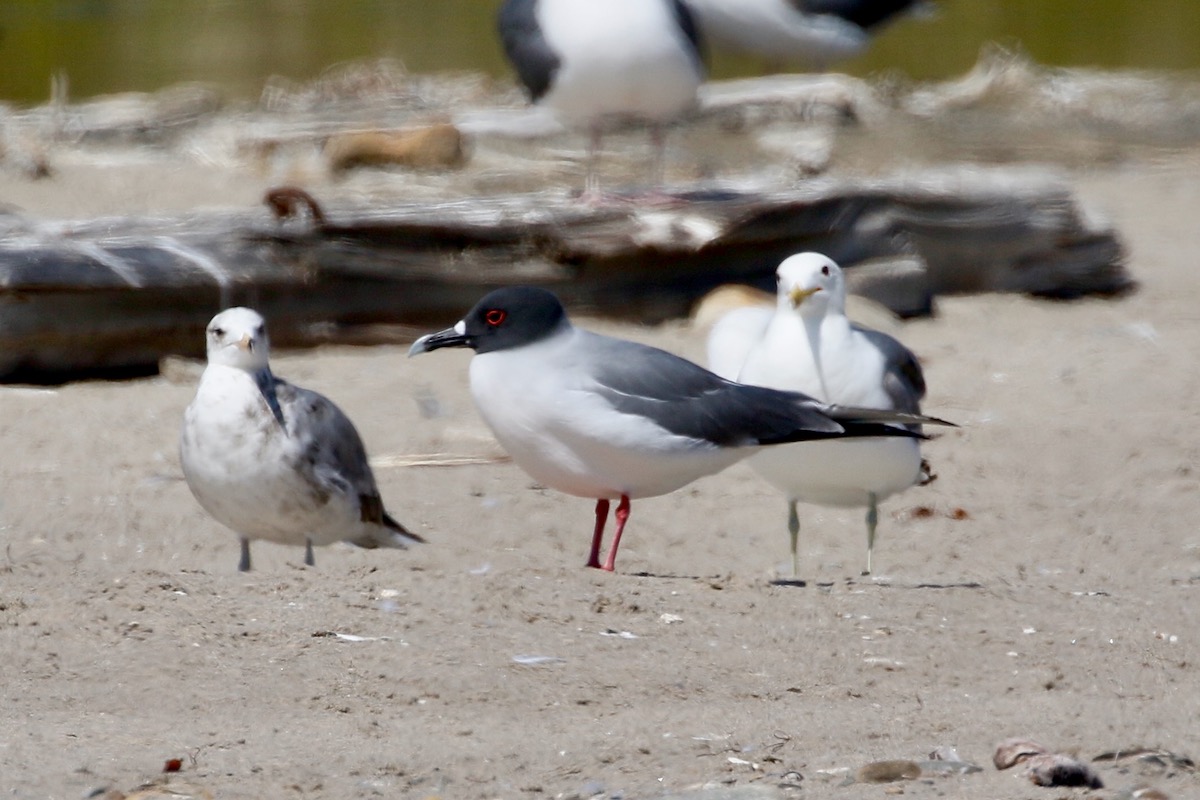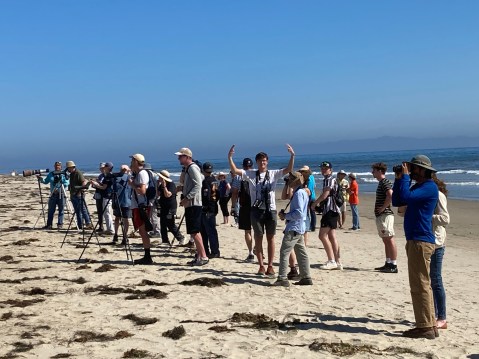A Mega Rarity Appears in Goleta
All Gulls are Not Created Equal; Our Columnist Recounts the Great Adventure of the Swallow-Tailed Gull Sighting

All Gulls are Not Created Equal; Our Columnist Recounts the Great Adventure of the Swallow-Tailed Gull Sighting

There are certain bird sightings that are so outstanding that they will be talked about and relived for years to come. On July 19, local birder Eunice Schroeder was checking out the resting gulls on the slough at Goleta Beach County Park, and amongst the western and California gulls, she noticed one that looked quite different. It had a dark hood and a bright red ring around its eye. She took a few photos and consulted her app field guides. There was no match.
Puzzled, she went home, looked at her bird books without finding a likeness to the mystery bird, then uploaded her photos. She decided to enlist the help of others, so she put a picture on the local birding Slack channel. Within minutes, Alex Castelein responded that the bird was a swallow-tailed gull.
Mayhem ensued. Those who could dropped what they were doing and made a beeline for Goleta beach.


[Click to enlarge] The swallow-tailed gull in flight: what a sight! Right: Here you can see the forked tail that gives the bird its name. | Credit: Hugh Ranson
What’s so special about a gull? I hear you ask. Aren’t gulls scavengers, the rats of the bird world? Not all gulls are created equal. First, there’s the swallow-tailed gulls’ incredible rarity. Schroeder had happened upon only the sixth record of the swallow-tailed gull for all of North America. The stronghold of the species is in the Galapagos Islands, with a few breeding on islands off the coast of Columbia. Then there are the bird’s habits. The swallow-tailed gull is the only nocturnal gull species in the world; it rests during the day then heads out to sea at night to feed on the squid that come up from the depths to feed at the surface.
But above all, and most birders would agree, the bird’s elegance is second-to-none. Because of its nocturnal habits, the red-rimmed eye is quite large, giving the bird a gentle expression. The pale-tipped bill is long and drooping, and the short legs are bubblegum pink. The wings are long and the tail forked, hence the bird’s name.
What would a bird usually found at the equator be doing in Goleta? The answer has probably to do with the strong El Niño that is brewing in equatorial waters. Cooler waters tend to be the most nutrient rich; the warmer the water, the less food there is. So it makes sense that equatorial birds would be driven to the north or south to find rich feeding grounds. The Goleta bird had wandered 3,000 miles.
It was around lunchtime when I caught wind of the bird. My wife Trisa and I were about to head over to Third Window for a burger and a pint when my phone buzzed with the news. Trisa was understanding and gave her blessing, and I was out of the door. Third Window would still be there tomorrow, but the gull might not.
I arrived at Goleta Beach within 15 minutes to find lots of wild-eyed birders but zero gulls. We had quick conversations about where the gull might have gone, and then we spread out to search the coastline. I volunteered to walk from Goleta Beach to More Mesa. Others checked the Santa Barbara Harbor area, the beaches at UCSB and Devereux, Haskell’s Beach, and one intrepid birder even went to the Santa Ynez River mouth near Lompoc. There were quite a few gulls around, but none with a dark hood and forked tail. Hours passed and hopes faded.

Then I received a phone call from a birder who’d seen an unfamiliar dark-headed gull at the mouth of Devereux Slough some hours before. It had to be the bird! I spread the word, and several birders, including myself, converged on Sands Beach. There was a good selection of gulls loafing above the tide line, but not The One. Where on earth had it gone? I went back to Goleta Beach in the hope that it had returned to its original spot. No joy.
It was nearly 4 p.m., my phone told me I’d walked over 20,000 steps, my feet were weary, and I had to go home. I’d given up. I was waiting for the light to change at the Mission Street offramp when I felt my phone buzz. The gull was back! It had turned up again at Sands Beach. So back I raced.
After parking the car, it was another half mile to where the gull was being seen, and I began to run, forgetting about the hamstring pull I’d picked up playing soccer the previous weekend. Mistake. I hobbled in pain down the beach towards the distant assembled group of 30 birders, hoping beyond hope that the bird would stay put till I arrived. It did.
And what a bird! It sat dozing at the front of a group of ordinary gulls, occasionally opening its eyes and stretching its neck. There was a festive mood amongst those gathered — we knew this was a once in a lifetime event. Even beachgoers wandering by were caught up in the excitement, taking a look at the celebrity through powerful scopes.
More birders arrived — some had come from as far as Riverside to the south and San Luis Obispo to the north. I saw birders I hadn’t seen in years. Some stayed until dusk to see the swallow-tailed gull take flight with other gulls and disappear up the coast to the west, never to be seen again, frustrating the crowds who came to see it the following day.
That night I awoke in the early morning hours, and my mind turned to the swallow-tailed gull. I imagined the bird, alone, a pale figure hovering over wine-dark seas, swooping down to pluck a squid from the surface, and then moving on to who knows where.
Hugh Ranson is a member of Santa Barbara Audubon Society, a nonprofit organization that protects area birdlife and habitat and connects people with birds through education, conservation, and science. For more information, see SantaBarbaraAudubon.org.
Please note this login is to submit events or press releases. Use this page here to login for your Independent subscription
Not a member? Sign up here.
You must be logged in to post a comment.